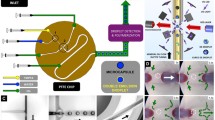Abstract
Inertial confinement fusion, frequently referred to as ICF, inertial fusion, or laser fusion, is a means of producing energy by imploding small hollow microspheres containing thermonuclear fusion fuel. Polymer microspheres, which are used as fuel containers, can be produced by solution-based micro-encapsulation technique better known as density-matched emulsion technique. The specifications of these microspheres are very rigorous, and various aspects of the emulsion hydrodynamics associated with their production are important in controlling the final product. This paper describes about the optimization of various parameters associated with density-matched emulsion method in order to improve the surface smoothness, wall thickness uniformity and sphericity of hollow polymer microspheres. These polymer microshells have been successfully fabricated in our lab, with 3–30 µm wall thickness and 50–1600 µm diameters. The sphericity and wall thickness uniformity are better than 99%. Elimination of vacuoles and high yield rate has been achieved by adopting the step-wise heating of W1/O/W2 emulsion for solvent removal.
Similar content being viewed by others
References
J H Campbell, J Z Granes and J F Poco, Technol. Repts., Lawrence Livermore National Laboratory, Livermore, CA, Nov. (1983), UCRL 53516
Modeling of Laser Imprint Inertial Confinement Fusion Targets. LLE Review, vol. 80
S Bodner, Phys. Rev. Lett. 33, 761 (1974)
Leon J Radziemski and David A Cramers, Laser induced plasma and applications (Marcel-Dekker Inc., New York, USA, 1989)
Stephen E Bodner, Denis G Colombant, John M Gardener, Robert H Lehmberg, Stephen P Obenschrin, Lee Phillips, Andrew J Schmitt and John D Sethiana, Phys. Plasmas 5, 1901 (1998)
J D Lindll, Nuclear Fusion 14, 511 (1974)
J Nuckolls, ICF target physics overview-tropical meeting on inertial confinement fusion (OSA, San Diego, Feb. 1980)
S Voyutsky, Colloid chemistry (Mir Publisher, Moscow)
Surfaces, interfaces and colloids: Principles and applications (Drew Myers, Wiley-VCH, 1999)
M Satake, Y Hayashi, Y Mido, S A Iqbal and M S Sethi, Colloidal and surface chemistry (Discovery Publishing House, 1996)
U Kubo and H Tsubakihara, J. Vac. Sci. Technol. A5, 2778 (1987)
T Norimatsu, M Takagi, Y Izawa, S Nakai and C Yamanka, J. Vac. Sci. Technol. A5, 2785 (1987)
R L Whitman, R H Day, R P Kurger and D M Stupin, Appl. Opt. 18, 1266 (1979)
B W Wienstein, J. Appl. Phys. 46, 5305 (1975)
Author information
Authors and Affiliations
Rights and permissions
About this article
Cite this article
Mishra, K., Khardekar, R., Singh, R. et al. Fabrication of polystyrene hollow microspheres as laser fusion targets by optimized density-matched emulsion technique and characterization. Pramana - J Phys 59, 113–131 (2002). https://doi.org/10.1007/s12043-002-0036-1
Received:
Revised:
Issue Date:
DOI: https://doi.org/10.1007/s12043-002-0036-1




